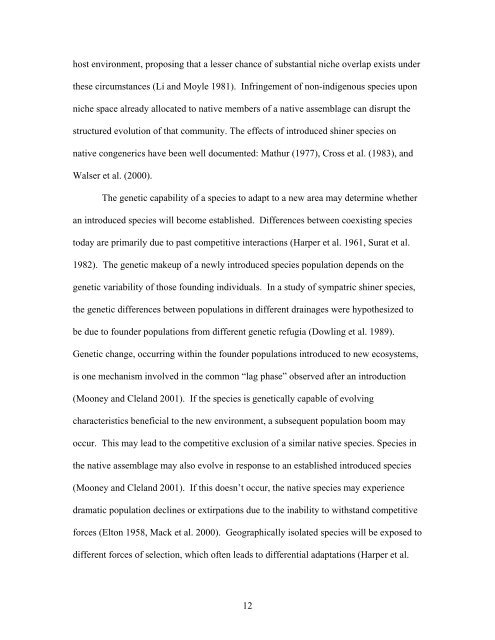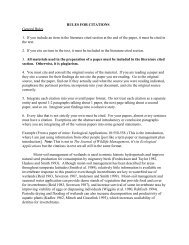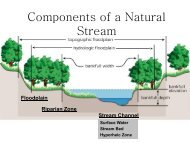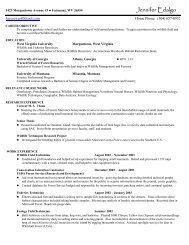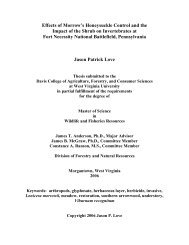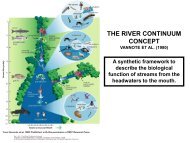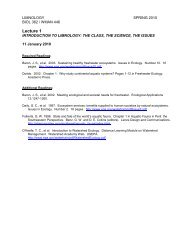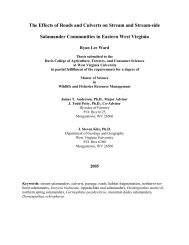An Experimental Study of Vertical Habitat Use and Habitat Shifts in ...
An Experimental Study of Vertical Habitat Use and Habitat Shifts in ...
An Experimental Study of Vertical Habitat Use and Habitat Shifts in ...
You also want an ePaper? Increase the reach of your titles
YUMPU automatically turns print PDFs into web optimized ePapers that Google loves.
host environment, propos<strong>in</strong>g that a lesser chance <strong>of</strong> substantial niche overlap exists under<br />
these circumstances (Li <strong>and</strong> Moyle 1981). Infr<strong>in</strong>gement <strong>of</strong> non-<strong>in</strong>digenous species upon<br />
niche space already allocated to native members <strong>of</strong> a native assemblage can disrupt the<br />
structured evolution <strong>of</strong> that community. The effects <strong>of</strong> <strong>in</strong>troduced sh<strong>in</strong>er species on<br />
native congenerics have been well documented: Mathur (1977), Cross et al. (1983), <strong>and</strong><br />
Walser et al. (2000).<br />
The genetic capability <strong>of</strong> a species to adapt to a new area may determ<strong>in</strong>e whether<br />
an <strong>in</strong>troduced species will become established. Differences between coexist<strong>in</strong>g species<br />
today are primarily due to past competitive <strong>in</strong>teractions (Harper et al. 1961, Surat et al.<br />
1982). The genetic makeup <strong>of</strong> a newly <strong>in</strong>troduced species population depends on the<br />
genetic variability <strong>of</strong> those found<strong>in</strong>g <strong>in</strong>dividuals. In a study <strong>of</strong> sympatric sh<strong>in</strong>er species,<br />
the genetic differences between populations <strong>in</strong> different dra<strong>in</strong>ages were hypothesized to<br />
be due to founder populations from different genetic refugia (Dowl<strong>in</strong>g et al. 1989).<br />
Genetic change, occurr<strong>in</strong>g with<strong>in</strong> the founder populations <strong>in</strong>troduced to new ecosystems,<br />
is one mechanism <strong>in</strong>volved <strong>in</strong> the common “lag phase” observed after an <strong>in</strong>troduction<br />
(Mooney <strong>and</strong> Clel<strong>and</strong> 2001). If the species is genetically capable <strong>of</strong> evolv<strong>in</strong>g<br />
characteristics beneficial to the new environment, a subsequent population boom may<br />
occur. This may lead to the competitive exclusion <strong>of</strong> a similar native species. Species <strong>in</strong><br />
the native assemblage may also evolve <strong>in</strong> response to an established <strong>in</strong>troduced species<br />
(Mooney <strong>and</strong> Clel<strong>and</strong> 2001). If this doesn’t occur, the native species may experience<br />
dramatic population decl<strong>in</strong>es or extirpations due to the <strong>in</strong>ability to withst<strong>and</strong> competitive<br />
forces (Elton 1958, Mack et al. 2000). Geographically isolated species will be exposed to<br />
different forces <strong>of</strong> selection, which <strong>of</strong>ten leads to differential adaptations (Harper et al.<br />
12


